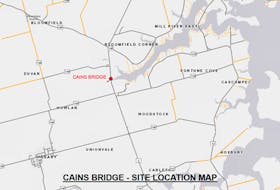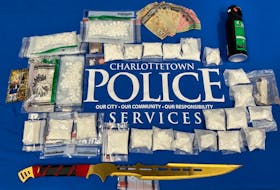There was a time when Martin O'Brien held to a dream of becoming a professional golfer.
"It was a business decision not to turn pro," the Woodstock resident confides.
He had come to the realization it was not going to be a money-making proposition.
O'Brien studied at Lindenwood University in Missouri on a golf scholarship, graduating with his Masters in Business in 2009.
"Oysters were there after all that," he said.
He'd been around the water all his life and had helped his parents on their leases during the summers while in college, before getting into the business himself.
There's still plenty of sharing of the workload.
"It's a nice lifestyle," he said. "We have fun, lots of laughs. We get to hang out on the water. We work hard."
He golfs when he can find the time, but so far this year, all of his time is taken up working at his oyster business.
He's the president of Cascumpec Bay Oyster Company, in the business of supplying quality, uniform oysters to select customers.
Most of his are destined for Ontario and Quebec.
"As far as simply selling oysters, that's no problem, especially good quality oysters."
O'Brien, 29, has owned the company since one year after graduating from Lindenwood.
He works off-bottom leases in Cascumpec Bay and operates a processing plant in Ellerslie.
"You start with spat collecting, which happens about July. It's just something that naturally occurs in the wild," O'Brien explains.
"You set out cement collectors that catch them. Then, after a month or two they're big enough that you can break them off and then you start your off-bottom culture."
Then it's a matter of tending to the tiny oysters as they grow to marketable size.
Long lines of floating cages, each holding four to six bags of oysters, must be graded and sized at least once a year.
He has a floating grading station right on his lease where he and fellow workers are kept busy from early spring to late fall redistributing the contents of the bags into more bags as the oysters grow.
"We put a lot of work into it, grading our seed and tumbling our oysters to encourage good growth. Just allowing them to be on the surface has them in a water column that has the most nutrients, and the cages being able to rock... around on the waves, encourages good growth," O'Brien explained.
There was a time when Martin O'Brien held to a dream of becoming a professional golfer.
"It was a business decision not to turn pro," the Woodstock resident confides.
He had come to the realization it was not going to be a money-making proposition.
O'Brien studied at Lindenwood University in Missouri on a golf scholarship, graduating with his Masters in Business in 2009.
"Oysters were there after all that," he said.
He'd been around the water all his life and had helped his parents on their leases during the summers while in college, before getting into the business himself.
There's still plenty of sharing of the workload.
"It's a nice lifestyle," he said. "We have fun, lots of laughs. We get to hang out on the water. We work hard."
He golfs when he can find the time, but so far this year, all of his time is taken up working at his oyster business.
He's the president of Cascumpec Bay Oyster Company, in the business of supplying quality, uniform oysters to select customers.
Most of his are destined for Ontario and Quebec.
"As far as simply selling oysters, that's no problem, especially good quality oysters."
O'Brien, 29, has owned the company since one year after graduating from Lindenwood.
He works off-bottom leases in Cascumpec Bay and operates a processing plant in Ellerslie.
"You start with spat collecting, which happens about July. It's just something that naturally occurs in the wild," O'Brien explains.
"You set out cement collectors that catch them. Then, after a month or two they're big enough that you can break them off and then you start your off-bottom culture."
Then it's a matter of tending to the tiny oysters as they grow to marketable size.
Long lines of floating cages, each holding four to six bags of oysters, must be graded and sized at least once a year.
He has a floating grading station right on his lease where he and fellow workers are kept busy from early spring to late fall redistributing the contents of the bags into more bags as the oysters grow.
"We put a lot of work into it, grading our seed and tumbling our oysters to encourage good growth. Just allowing them to be on the surface has them in a water column that has the most nutrients, and the cages being able to rock... around on the waves, encourages good growth," O'Brien explained.








